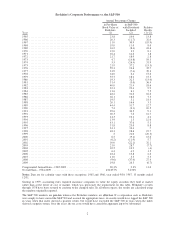Berkshire Hathaway 2009 Annual Report Download - page 14
Download and view the complete annual report
Please find page 14 of the 2009 Berkshire Hathaway annual report below. You can navigate through the pages in the report by either clicking on the pages listed below, or by using the keyword search tool below to find specific information within the annual report.Dave Sokol, the enormously talented builder and operator of MidAmerican Energy, became CEO of
NetJets in August. His leadership has been transforming: Debt has already been reduced to $1.4 billion, and, after
suffering a staggering loss of $711 million in 2009, the company is now solidly profitable.
Most important, none of the changes wrought by Dave have in any way undercut the top-of-the-line
standards for safety and service that Rich Santulli, NetJets’ previous CEO and the father of the fractional-
ownership industry, insisted upon. Dave and I have the strongest possible personal interest in maintaining these
standards because we and our families use NetJets for almost all of our flying, as do many of our directors and
managers. None of us are assigned special planes nor crews. We receive exactly the same treatment as any other
owner, meaning we pay the same prices as everyone else does when we are using our personal contracts. In short,
we eat our own cooking. In the aviation business, no other testimonial means more.
Finance and Financial Products
Our largest operation in this sector is Clayton Homes, the country’s leading producer of modular and
manufactured homes. Clayton was not always number one: A decade ago the three leading manufacturers were
Fleetwood, Champion and Oakwood, which together accounted for 44% of the output of the industry. All have
since gone bankrupt. Total industry output, meanwhile, has fallen from 382,000 units in 1999 to 60,000 units in
2009.
The industry is in shambles for two reasons, the first of which must be lived with if the U.S. economy
is to recover. This reason concerns U.S. housing starts (including apartment units). In 2009, starts were 554,000,
by far the lowest number in the 50 years for which we have data. Paradoxically, this is good news.
People thought it was good news a few years back when housing starts – the supply side of the picture
– were running about two million annually. But household formations – the demand side – only amounted to
about 1.2 million. After a few years of such imbalances, the country unsurprisingly ended up with far too many
houses.
There were three ways to cure this overhang: (1) blow up a lot of houses, a tactic similar to the
destruction of autos that occurred with the “cash-for-clunkers” program; (2) speed up household formations by,
say, encouraging teenagers to cohabitate, a program not likely to suffer from a lack of volunteers or; (3) reduce
new housing starts to a number far below the rate of household formations.
Our country has wisely selected the third option, which means that within a year or so residential
housing problems should largely be behind us, the exceptions being only high-value houses and those in certain
localities where overbuilding was particularly egregious. Prices will remain far below “bubble” levels, of course,
but for every seller (or lender) hurt by this there will be a buyer who benefits. Indeed, many families that couldn’t
afford to buy an appropriate home a few years ago now find it well within their means because the bubble burst.
The second reason that manufactured housing is troubled is specific to the industry: the punitive
differential in mortgage rates between factory-built homes and site-built homes. Before you read further, let me
underscore the obvious: Berkshire has a dog in this fight, and you should therefore assess the commentary that
follows with special care. That warning made, however, let me explain why the rate differential causes problems
for both large numbers of lower-income Americans and Clayton.
The residential mortgage market is shaped by government rules that are expressed by FHA, Freddie
Mac and Fannie Mae. Their lending standards are all-powerful because the mortgages they insure can typically
be securitized and turned into what, in effect, is an obligation of the U.S. government. Currently buyers of
conventional site-built homes who qualify for these guarantees can obtain a 30-year loan at about 5
1
⁄
4
%. In
addition, these are mortgages that have recently been purchased in massive amounts by the Federal Reserve, an
action that also helped to keep rates at bargain-basement levels.
In contrast, very few factory-built homes qualify for agency-insured mortgages. Therefore, a
meritorious buyer of a factory-built home must pay about 9% on his loan. For the all-cash buyer, Clayton’s
homes offer terrific value. If the buyer needs mortgage financing, however – and, of course, most buyers do – the
difference in financing costs too often negates the attractive price of a factory-built home.
12
























